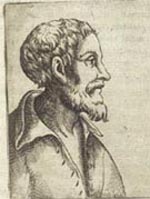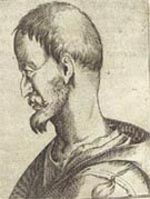|
Antoinette Le Normand-Romain
« Accentuating individuality so as to speak to the masses » : the exemplary cases of David d'Angers and of Rodin
In the early nineteenth century physiognomy such as it had been practised since the Renaissance gave way to the phrenology of Franz Joseph Gall. The latter was convinced that the external envelope of the skull depends on the shape of the cerebral mass beneath, and that this was composed of as many organs as faculties, tendencies and feelings. He sought to localise the different functions of the brain and to establish a topography of man’s moral and intellectual faculties. Phrenology was thus a science of the relationship between the external and the internal, between the visible surface and the internal world. It developed in two directions, one psychological and moral, the other ‘anthropological’, including considerations on criminality which were very popular. Writers and artists in particular strove to identify and to place the ‘stigmata of criminal insanity’, before giving way to the new ‘positivist’ school of criminal anthropology founded by Lombroso.
Our aim in this paper is not to linger on this point ror on the study of race, but rather to see the application of the purportedly scientific approach to portraiture as evidenced by two case studies, David d’Angers and Rodin. Certainly Rodin’s generation no longer believed in phrenology as enthusiastically as the Romantics had done. But for both artists there was a direct link between the physical and the moral, with the first necessarily leading on to the second, and with the portrait consequently being viewed as the depiction of the internal man rather than the image of his features. However, for David, sculpture’s mission was to ‘represent the apotheosis of great men’ and to achieve this the sculptor was not obliged to observe scrupulous exactness. ‘Phrenology’, he remarked, ‘is an indispensable form of knowledge for the artist. It allows us to discern on the skull of the individual the distinctive qualities which compose the face. The face is the mirror of a man’s faculties. It is important to make the monumental structure of being stand out so as to make a strong impression on the spectator and to make him think’.
For Rodin, in contrast, the artist must faithfully respect nature which will guide him towards truths hidden below the surface. In the same way it was the model who guided him towards the subject (and not the opposite), and he believed that each region had its own morphology and thus chose his models with regard to their geographical origins : the statue of Balzac was exemplary of this approach. The study of the model was, however, only a starting point, for he sought to suggest the passions – or the power of a novelist like Balzac – in a direct way and without recourse to a symbolic or allegorical language. With a kind of backward step, the work of expression which was the object of one of the Ecole des Beaux-Arts’s most famous competitions (the ‘tête d’expression’ prize) caused phrenology to disappear.
Thanking David for having sent him a series of medals, Goethe paid hommage to the sculptor ‘for exploring the secrets of nature with lively gaze and, consummate master of technique, for being able to express before our eyes what is most intimate’. Neither David not Rodin gave up on this mission, though they understood it in different ways. Their paths diverged because the gaze that they cast on nature was different.
« Acentuer l'individualité pour parler aux masses » : les cas exemplaires de David d'Angers et Rodin
Le XIXème siècle commençant voit la physiognomonie pratiquée depuis la Renaissance, céder la place à la phrénologie de Franz Joseph Gall. Convaincu que l’enveloppe extérieure du crâne dépend de la conformation de la masse cérébrale qui se trouve au-dessous, celle-ci étant composé d’autant d’organes qu’il y a de faculté, penchants, sentiments, Gall cherche à localiser les différentes fonctions du cerveau et tente d’établir une topographie des facultés morales et intellectuelles de l’homme.
Science du rapport entre extérieur et intérieur, surface visible et monde intérieur, cette science se développe dans deux directions : l’une psychologique et morale, l’autre « ethnographique » dans laquelle s’inscrit la réflexion sur la criminalité qui connait un vif succès : écrivains et des artistes en particulier s’efforcent d’identifier et de repérer les « stigmates de la folie criminelle », avant de céder la place à la nouvelle école d’anthropologie criminelle « positive » fondée par Lombroso.
Notre propos n’est pas de nous attarder sur ce point ni sur l’étude des races, mais plutôt de voir l’application de cette approche -qui se veut scientifique- au domaine du portrait, à partir de deux cas exemplaires, David d’Angers et Rodin. Certes la génération de Rodin ne croit plus guère en la phrénologie, qu’avait tant appréciée les romantiques ; mais, pour l’un comme pour l’autre, il y a un lien étroit entre le physique et le moral, le premier conduisant nécessairement vers le second, et le portrait se devant d’être celui de l’homme intérieur plutôt que l’image de ses traits. Cependant, pour David, la sculpture a pour mission de « représenter l’apothéose des grands hommes » et, pour y parvenir, le sculpteur n’est pas tenu à une exactitude scrupuleuse : « La phrénologie, disait-il, est une science indispensable à l’artiste. C’est la phrénologie qui permet de discerner sur le crâne d’un individu les qualités distinctives dont les traits de la face sont la résultante. La face est le miroir des facultés de l’homme. Il est important de rendre saillante la structure monumentale de l’être, afin de faire penser le spectateur en l’impressionnant fortement.»
En revanche, pour Rodin, l’artiste doit respecter fidèlement la nature qui le guidera vers la vérité qui se cache derrière l’apparence. C’est ainsi que de même que c’est le modèle qui le guide vers le sujet et non l’inverse, il croit à une morphologie propre à chaque région, et choisit donc ses modèles en fonction de leur origine géographique : la statue de Balzac offre une application exemplaire de cette démarche.
Toutefois l’étude du modèle n’est qu’un point de départ car il veut suggérer les passions -ou la puissance d’un romancier comme Balzac- d’une façon directe, sans recours donc au langage symbolique ou allégorique. Par une sorte de retour en arrière, la phrénologie s’efface devant le travail sur l’expression qui faisait l’objet d’un des concours les plus renommés de l’Ecole des Beaux-Arts, le concours dit « de la tête d’expression ».
Remerciant David de lui avoir envoyé une série de médaillons, Goethe rendait hommage au sculpteur « qui scrute d’un regard vivant les secrets de la nature et, maître consommé dans sa technique, est capable de traduire sous nos yeux ce qu’il y a de plus intime. » Ni David ni Rodin ne faillirent à cette mission, même s’ils ne la comprenaient pas de la même façon : leurs chemins divergeaient car le regard qu’ils posaient sur la nature était différent.
Go back to Physiognony from Lavater to the Great War
|
|
|
|



